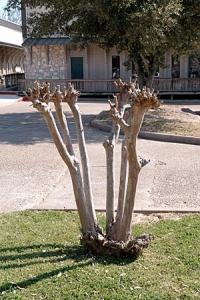Crape Myrtle: Prune It, Don’t Decapitate It
By Gil Medeiros, Fairfax Master Gardener
Crape myrtles need to be topped every year, right?
Nonsense! If the tree is properly sited – meaning, its location can accommodate its mature size – then the crape myrtle needs no more pruning than any other tree. In fact, when pruning is done properly and sparingly a crape myrtle will produce beautiful flowers that are well supported and long lasting. Furthermore, the tree will resist disease and pests with the best of them. When crape myrtles are topped every year, they are susceptible to rot and insect infestation; often they can’t support the flowers they produce, and they look awful.

Let’s have a show of hands. How many of you think the crape myrtle in this photo looks good? Unfortunately, this crape myrtle needed to be topped because it was planted too close to a roadway.
Why, then, is topping and general disfiguration of crape myrtles so prevalent? I’ll offer a few guesses:
- Homeowners think it is the right thing to do because they see it everywhere. No one ever told them that it’s not right, and the tree hasn’t died yet. Yet.
- The untrained “landscapers” frequently hired to prune these crape myrtles recommend this type of pruning to unwary homeowners. Maybe the landscapers don’t know better. It is certainly a cheap and fast way to prune the crape myrtle. There is no need for ladders, no need for aesthetic talent; the landscaper simply cuts off everything at about 5 feet–smooth, clean and easy. The result looks horrible in winter, but winter days are short; maybe no one will notice.
- Whoever decided to plant that crape myrtle didn’t consider how big it would grow and now someone else must struggle to keep it within bounds.
The right way

This is how a mature crape myrtle should look
Right plant, right place: If you plan to plant a crape myrtle, make sure the site can handle the mature size of the cultivar. Don’t put a crape myrtle too close to the house or driveway or walking paths. Don’t put it under power lines either. Find a dwarf variety for these sites, and leave some margin in the event the dwarf variety grows larger than expected. There are many great dwarf varieties of crape myrtle that thrive in Virginia.
Make thinning cuts as needed: (See Why we prune deciduous trees and shrubs.) Remove crossing and rubbing branches. Open up the interior of the tree to allow air to circulate; this will reduce the possibility of powdery mildew formation. In making these alterations, maintain the natural vase shape of the tree.
That’s all there is to it.
Making do
Suppose you are maintaining a crape myrtle that is too large for the site, and you don’t want to remove it. Maybe you planted it out of ignorance, or perhaps a previous homeowner put it there. (A third possibility: You asked the landscaper to plant a dwarf variety, and unbeknownst to you, he planted a full-sized crape myrtle. That’s my story, and I’m sticking to it.)
Use canopy reduction cuts to control the size of the tree. These are similar to thinning cuts. (See Why we prune deciduous shrubs and trees.) Cut branches back to laterals that are at least one-third the diameter of the branch being removed. The removed branch should, of course, be shorter than the remaining lateral in order to achieve the goal of size reduction. These cuts will stimulate new growth throughout the tree, not just at the point of the cut. Take care to maintain the natural vase shape of the tree, and remember to make cuts that do not damage the collar at the intersections of the limbs.
Use heading cuts sparingly. (See Why We Prune Deciduous Shrubs and Trees.) Use them only on small branches, preferably not older than one year. Never use a heading cut on a thick, older branch. This will produce a large wound and a thick growth of new shoots near the cut. This is what we are trying to avoid.
No more ugly stumps, please.
References
Pruning Crapemyrtles, VCE publication 430-451
Crapemyrtle Pruning, University of Florida IFAS Extension
How to Prune Trees, Bedker, O’Brien, and Mielke, USDA Forestry Service, NA-FR-01-95